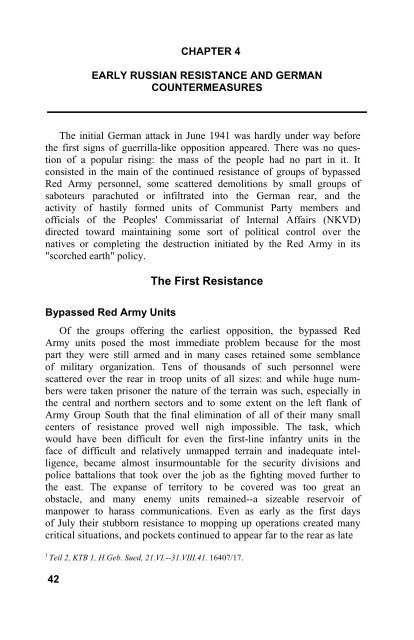the soviet partisan movement 1941-1944 by edgar m. howell
the soviet partisan movement 1941-1944 by edgar m. howell
the soviet partisan movement 1941-1944 by edgar m. howell
You also want an ePaper? Increase the reach of your titles
YUMPU automatically turns print PDFs into web optimized ePapers that Google loves.
CHAPTER 4 <br />
EARLY RUSSIAN RESISTANCE AND GERMAN<br />
COUNTERMEASURES <br />
The initial German attack in June <strong>1941</strong> was hardly under way before<br />
<strong>the</strong> first signs of guerrilla-like opposition appeared. There was no question<br />
of a popular rising: <strong>the</strong> mass of <strong>the</strong> people had no part in it. It<br />
consisted in <strong>the</strong> main of <strong>the</strong> continued resistance of groups of <strong>by</strong>passed<br />
Red Army personnel, some scattered demolitions <strong>by</strong> small groups of<br />
saboteurs parachuted or infiltrated into <strong>the</strong> German rear, and <strong>the</strong><br />
activity of hastily formed units of Communist Party members and<br />
officials of <strong>the</strong> Peoples' Commissariat of Internal Affairs (NKVD)<br />
directed toward maintaining some sort of political control over <strong>the</strong><br />
natives or completing <strong>the</strong> destruction initiated <strong>by</strong> <strong>the</strong> Red Army in its<br />
"scorched earth" policy.<br />
The First Resistance<br />
Bypassed Red Army Units<br />
Of <strong>the</strong> groups offering <strong>the</strong> earliest opposition, <strong>the</strong> <strong>by</strong>passed Red<br />
Army units posed <strong>the</strong> most immediate problem because for <strong>the</strong> most<br />
part <strong>the</strong>y were still armed and in many cases retained some semblance<br />
of military organization. Tens of thousands of such personnel were<br />
scattered over <strong>the</strong> rear in troop units of all sizes: and while huge numbers<br />
were taken prisoner <strong>the</strong> nature of <strong>the</strong> terrain was such, especially in<br />
<strong>the</strong> central and nor<strong>the</strong>rn sectors and to some extent on <strong>the</strong> left flank of<br />
Army Group South that <strong>the</strong> final elimination of all of <strong>the</strong>ir many small<br />
centers of resistance proved well nigh impossible. The task, which<br />
would have been difficult for even <strong>the</strong> first-line infantry units in <strong>the</strong><br />
face of difficult and relatively unmapped terrain and inadequate intelligence,<br />
became almost insurmountable for <strong>the</strong> security divisions and<br />
police battalions that took over <strong>the</strong> job as <strong>the</strong> fighting moved fur<strong>the</strong>r to<br />
<strong>the</strong> east. The expanse of territory to be covered was too great an<br />
obstacle, and many enemy units remained--a sizeable reservoir of<br />
manpower to harass communications. Even as early as <strong>the</strong> first days<br />
of July <strong>the</strong>ir stubborn resistance to mopping up operations created many<br />
critical situations, and pockets continued to appear far to <strong>the</strong> rear as late<br />
1<br />
Teil 2, KTB 1, H.Geb. Sued, 21.VI.--31.VIII.41. 16407/17.<br />
42
















